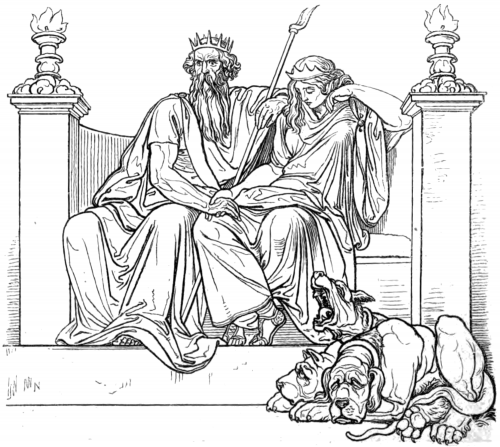Persephone, queen of the underworld and goddess of spring, lives at the heart of one of Greek mythology’s most profound and enduring myths. She moves between worlds—bright fields of renewal and the shadowy realm of the dead—carrying the rhythms of life and death within her story. As the daughter of Demeter and Zeus, she embodies both maidenhood and sovereignty, innocence and transformation.
Abducted by Hades yet later ruling beside him, Persephone bridges opposites: light and darkness, growth and decay, joy and sorrow. Her myth defines the Greek understanding of seasonal cycles, death and rebirth, and female empowerment through ordeal.

Symbolism
Persephone symbolizes duality—she is both the Kore (“maiden”) of springtime and the fearsome Queen of the Dead. She carries or is depicted with pomegranates (a symbol of the underworld), torches, flowers, and a diadem, reflecting her role in both fertility and finality.
Her annual departure and return from the underworld mark the changing seasons—her presence above brings spring and summer, her absence winter’s dormancy.
Appearances in Myth
- The Abduction: While gathering flowers in a meadow, Persephone is seized by Hades and carried to the underworld. Her mother, Demeter, in grief, causes the world’s crops to wither. Zeus finally intervenes, ordering Persephone’s return—but not before she eats a few pomegranate seeds, binding her to the underworld.
- The Compromise: Because of the pomegranate, Persephone must spend a portion of the year in the underworld and the rest above with her mother. This myth explains the seasons: her time below causes winter and fall; her return brings spring and summer.
- Queen of the Underworld: Unlike a passive captive, Persephone transforms into a sovereign. In later myths, she welcomes souls, presides over judgment, and acts as a powerful force in rites of rebirth. She is both feared and revered—not only as a goddess of the dead but as one who returns from death.
- The Eleusinian Mysteries: Persephone plays a central role in this secretive cult centered on death and rebirth. Initiates believed that by reenacting her descent and return, they could learn the secrets of immortality and achieve a blessed afterlife.
Worship and Cult
Persephone was venerated across Greece, especially alongside Demeter in Eleusis, where the Eleusinian Mysteries promised spiritual renewal. Her dual nature made her a focus for rites of passage—fertility, marriage, and mourning. Worshippers invoked her in both joyful and solemn ceremonies, reflecting her role as both nurturer and queen of shadows.
In Southern Italy and Sicily, Persephone’s cult flourished with distinct local myths and depictions, often blending with native underworld deities.
Modern Appearances
Literature
- Homeric Hymn to Demeter – The foundational text of her myth, recounting her abduction and return.
- The Metamorphoses by Ovid – Retells the pomegranate tale and emphasizes Persephone’s underworld identity.
Popular Culture
- Lore Olympus – A modern graphic novel that reimagines Persephone’s relationship with Hades as a love story.
- Hadestown (Broadway) – Loosely inspired by underworld myths, Persephone appears as a radiant but conflicted queen.
- The Sandman (Neil Gaiman) – Echoes Persephone’s archetype in dream-figures and underworld queens.
Art
- Artists across centuries depict her rising from the underworld or gathering flowers, frozen at the moment of transformation.
